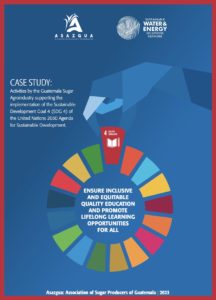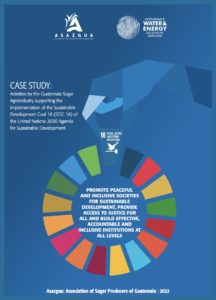The Guatemalan Sugar Industry has implemented new technologies and processes, both in sugarcane cultivation and in industrial activities, to reduce its water consumption.
Since 1992, with the creation of The Guatemalan Sugarcane Research and Training Center -Cengicaña-, research has been committed to the development of sustainable cultivation and production practices. For this reason, the Sugar Industry has implemented more efficient irrigation systems that use less water and apply only the amount that the plant needs.
Likewise, the sugar mills have invested in systems for the reuse of water in sugar factories. The water used in the manufacturing process is taken to a cooling system, since it comes out at a high temperature, where, after being cooled, it returns to the factory, through a recirculation system, to be used again.

Water footprint of the Guatemalan Sugar Industry
According to the study carried out by the Private Institute for Climate Change -ICC- each ton of sugarcane produced in Guatemala uses 45% less water than the rest of the sugarcane-producing countries.
During the 2020-2021 harvest, 76% of the water used to produce sugarcane in Guatemala was provided by rainwater. These data were presented by the Private Institute for Climate Change Research -ICC- in the report Water Footprint in Sugar Production in Guatemala.
During this period, the availability of rainwater for sugarcane cultivation increased by 3% compared to the previous harvest. That is, the weather conditions allowed more rainwater to be available for cultivation.

During the 2020-2021 harvest, irrigation water used for sugarcane production represented only 19% of the water footprint. This is 2% less compared to the previous harvest.






























